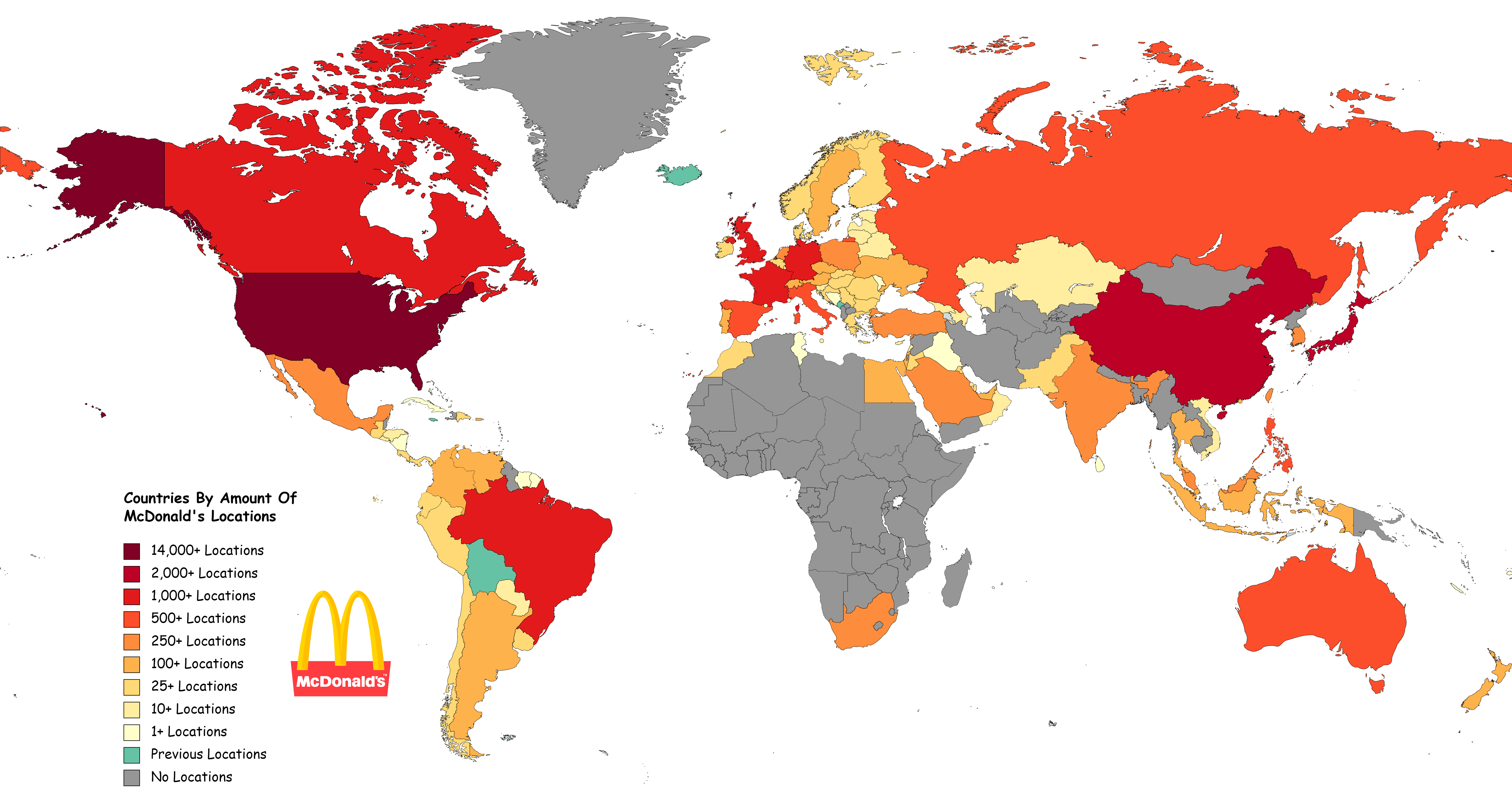McDonald's Global Presence Map


Marcus Rodriguez
Historical Geography Expert
Marcus Rodriguez specializes in historical cartography and geographic data analysis. With a background in both history and geography, he brings unique...
Geographic Analysis
What This Map Shows
The visualization titled "The McDonald's Empire" provides a comprehensive overview of McDonald's global presence, showcasing the density and distribution of its restaurants across different countries and regions. It effectively illustrates how this fast-food giant has infiltrated various markets, revealing insights into cultural preferences and economic factors that have influenced its expansion. With thousands of locations worldwide, McDonald's has become a cultural icon, and this map highlights the scale and reach of its operations.
Deep Dive into McDonald's Global Expansion
McDonald's, founded in 1940, has evolved from a small drive-in restaurant in California to one of the most recognizable brands in the world. The company's strategy has been to adapt its menu and business model to fit local tastes and preferences, which is a significant factor in its success. Ever wondered why you can find McDonald's in virtually every corner of the globe? It's all about localization.
For instance, in India, where a large portion of the population is vegetarian, McDonald's offers a range of vegetarian options, including the popular McAloo Tikki burger, which features a spiced potato patty. Similarly, in Japan, the menu includes items like the Teriyaki McBurger, catering to local flavor profiles. This adaptability has allowed McDonald's to penetrate diverse markets, turning it into a case study on globalization and local adaptation.
Interestingly, the number of McDonald’s locations is often reflective of a country’s economic development. More developed nations tend to have a higher density of McDonald's restaurants, which aligns with the fast-food culture seen in urban environments. According to recent statistics, the United States, the birthplace of McDonald's, boasts more than 14,000 locations, making it the country with the highest number of branches. In contrast, emerging markets like China and India are witnessing rapid growth in McDonald's outlets, catering to a burgeoning middle class that desires convenient dining options.
The company's global reach is not just a marketing triumph but also a reflection of broader economic trends. Fast food consumption is often linked to urbanization, as people move to cities and seek quick meal solutions. This trend is evident in countries like Brazil and South Africa, where McDonald's has established a strong presence amid expanding urban centers.
Regional Analysis
Breaking down the map by regions reveals fascinating contrasts in McDonald's penetration. In North America, the United States and Canada have a high concentration of restaurants, with the U.S. leading by a significant margin. The cultural embrace of fast food in these regions is evident, with McDonald's becoming a staple in the American lifestyle. Interestingly, Mexico also shows a robust presence, where McDonald's has adapted its menu to include local favorites, such as the McMollete.
In Europe, the UK and Germany stand out as leaders in McDonald's locations. The brand has successfully integrated into European dining habits, often competing with local fast-food chains. However, countries like France exhibit a more cautious approach, with a lower density of McDonald's, reflecting the French cultural emphasis on cuisine and dining experiences.
Conversely, in Asia, countries like China and India show an explosive growth pattern. China, with over 3,000 locations, represents one of the fastest-growing markets for McDonald's, driven by urbanization and changing lifestyles among the youth. India is also on a similar trajectory, with plans for further expansion as the company taps into the rising disposable income of its population.
Interestingly, Africa presents a mixed picture. While South Africa has embraced the fast-food culture with a significant number of outlets, other regions remain underrepresented, highlighting a potential area for growth. The map indicates that while McDonald's has made strides in urban areas, rural regions are still largely untouched, suggesting an opportunity for future expansion.
Significance and Impact
Understanding the global presence of McDonald's through this map is significant for several reasons. Firstly, it reflects broader economic trends, such as globalization, urbanization, and changing consumer preferences. McDonald's success is not merely a business achievement; it serves as a lens through which we can examine cultural dynamics and economic development in various regions.
Moreover, the impact of McDonald's extends beyond just food. It influences local economies, creates job opportunities, and even shapes urban landscapes. The presence of a McDonald's can often signify the arrival of modern retail and dining options in developing areas, impacting local businesses and communities.
As we look to the future, current trends suggest that McDonald's will continue to adapt and evolve in response to consumer demands and market conditions. With a focus on sustainability and healthier menu options, the company's trajectory will likely reflect changing societal values and preferences. The map not only serves as a record of McDonald's current global footprint but also hints at the future of fast food in an increasingly interconnected world.
Visualization Details
- Published
- October 11, 2025
- Views
- 68
Comments
Loading comments...